1. Zebra Plant (Calathea Zebrina)
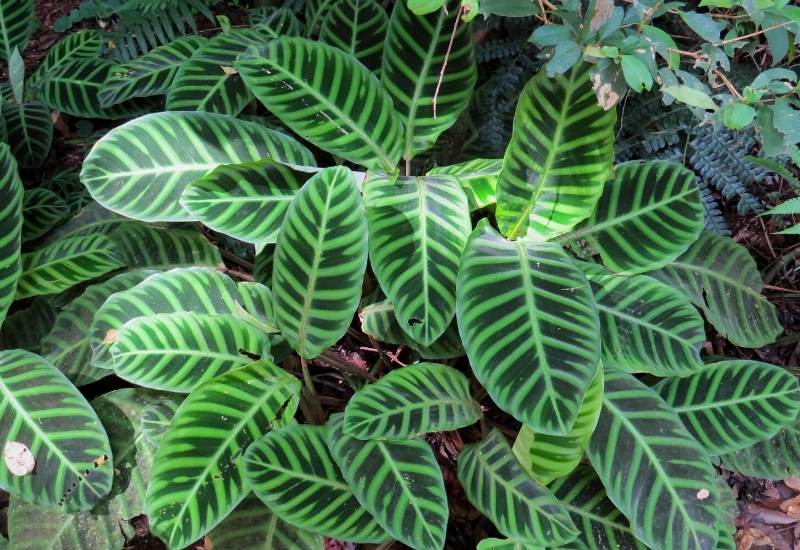
Zebra plant, a.k.a. Calathea zebrina, is one of the most popular varieties of this houseplant, and the name says it all… The leaves have contrasting diagonal dark and light green stripes that start from the midrib and end at the margins. These are matched by undulation, with the bright stripes in relief.
The texture is very original, as it feels like rubber to the touch! This makes the overall look of the plant oddly soft despite the eye-catching color display.
Each leaf is elliptical and up to 12 inches long (30 cm), with some pointing upwards and others arching to the sides.
The blooms are bright purple, short and wide; they come at the base of the plant and look like dahlias, which is somewhat unusual for prayer plants.
The Zebra plant is a classic of calatheas, ideal for the harmonic, almost neoclassical pattern on its leaves, which makes it suitable even for formal settings, like offices.
2. Rose Painted Calathea (Calathea Roseopicta)
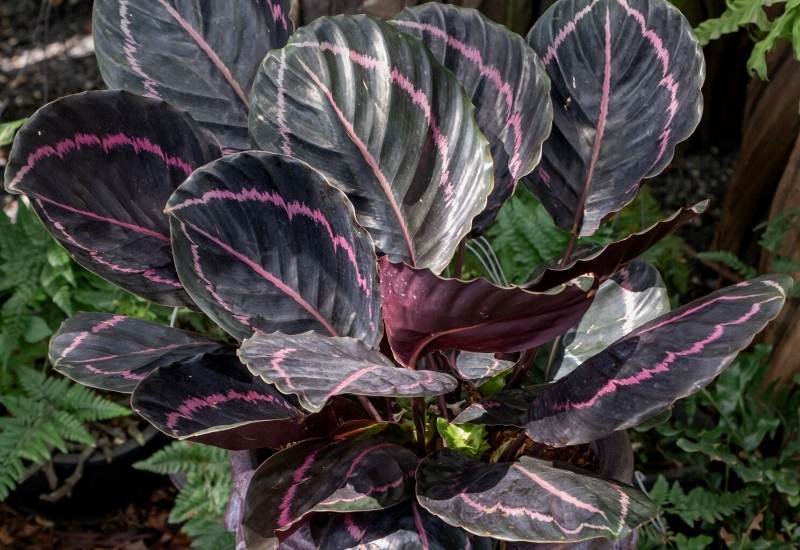
Rose painted calathea has some of the most colorful foliage of all the prayer plants in the world. Each variety has its own palette and personality, but they will have concentric areas that pick up the broad and waved shape of the leaves and use different colors.
You can find dark and bright greens, even cream and yellow, and as the name suggests, pink to purple especially on the undersides and stems.
Mind blowing varieties are the cultivars ‘Princess Jessie’ which is pink purple and almost black, with rich emerald green parts, or ‘Rosy’, with pinks and even lime or cream yellows!
The huge size of the leaves makes the display even more eye catching: up to 30 inches in length (76 cm)! The blooms are short but showy; you will find them at the base of your houseplant in shades from white to bright green, often lime.
Calathea roseopicta is the variety you want if you are after a centerpiece with an explosion of colors to brighten up your living room or office.
3. Calathea Warscewiczii (Calathea Warscewiczii)
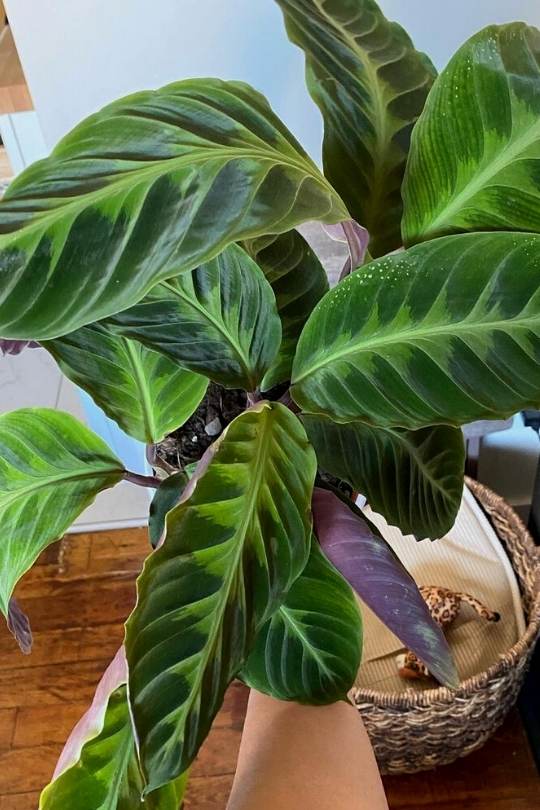
4. Peacock Plant (Calathea Makoyana)
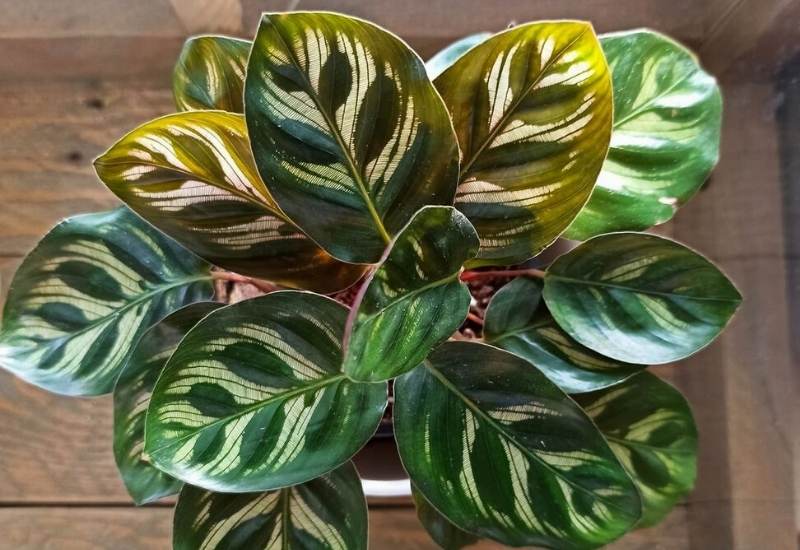
Peacock plant, or Calathea makoyana has foliage that looks like wide and broad feathers, hence the name. These are 12 inch long (30 cm) and about 8 inch wide (20 cm) egg shaped (ovate) and with an incredible pattern of cream yellow green and mid green glossy areas on the top, just like you would expect in the famous birds that give it its name.
This is then taken up on the undersides but with white and plum purple! It is really hard to decide which side is better… When they first appear, they are rolled up in pointed cones of a pink purple shade. The blooms are small and white, they appear in small clusters at the base of the plant.
Maybe the best setting for a peacock plant would be a modern and bold room, but it will look great anywhere you grow it.
5. Calathea Orbifolia (Calathea Orbifolia)
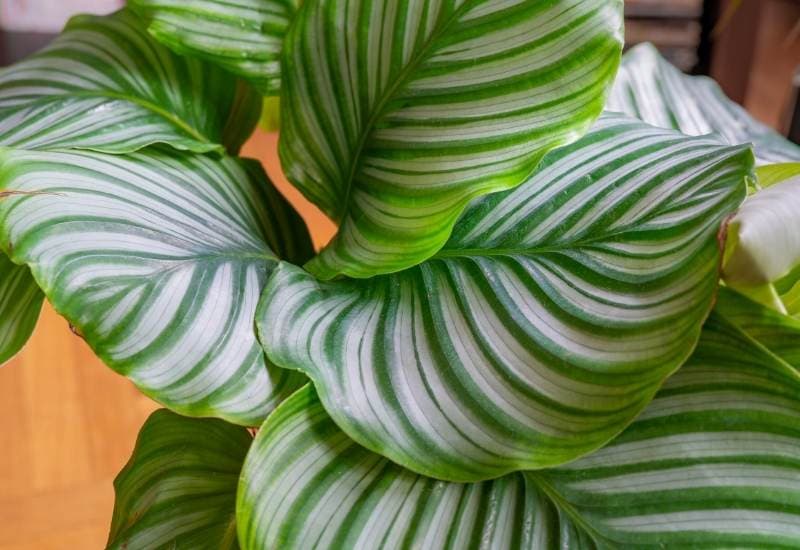
Calathea orbifolia will not strike you so much for the coloring of its foliage, but for its texture and shape. In fact the leaves of this prayer plant are mid or bright green with gentle darker stripes that run from the middle to the margins.
However, they are very glossy, deeply grooved with a midrib and plastic limes that go to the edges from it.
They are also very, very broad, in fact, they can be one foot long and wide (30 cm). They will come on short stems and create an exotic looking clump, almost like a shrub. The flowers are fairly small, short and they will appear with their cream white shade near the base of the plant.
For the tropical underbrush look, Calathea orbifolia is by far one of the best choices, and it will have a more neutral presence, which you can easily combine with other houseplants.
6. Calathea Ornata (Calathea Ornata)
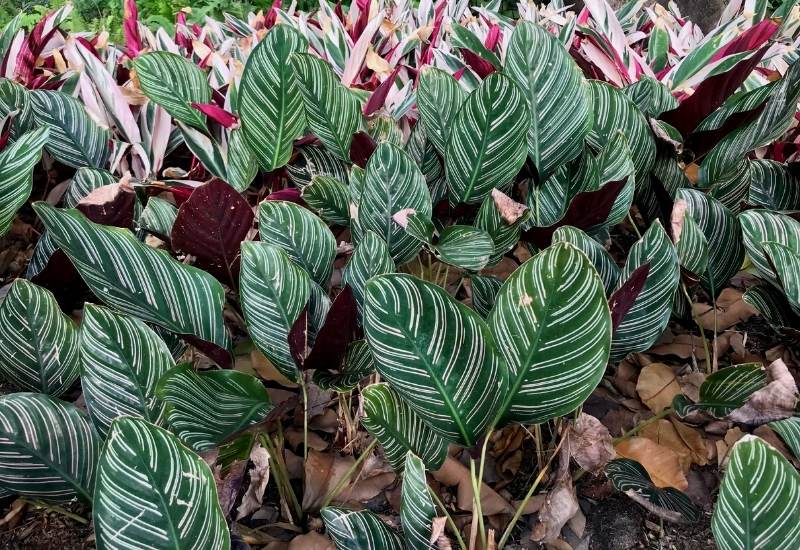
One of the most elegant varieties of this houseplant, Calathea ornata has very defined pictorial touches. This is thanks to its broad, long and pointed leaves, which are very dark green in shade, and with a glossy sheen.
This color is contrasted by groups of two to three thin white or pink stripes that curve from the mid rib to reach the margins, which they do not actually touch, leaving a frame for this modern looking natural painting.
The undersides are purple, and this adds another dimension of depth. The blooms can be bright orange, pink or white, they are very decorative and they come on long and upright stems that grow taller than the foliage itself.
Beautiful in any setting, Calathea ornata would be a magnificent presence in a modern looking, artistically inspired office or living room.
7. Eternal Flame (Calathea Crocata)
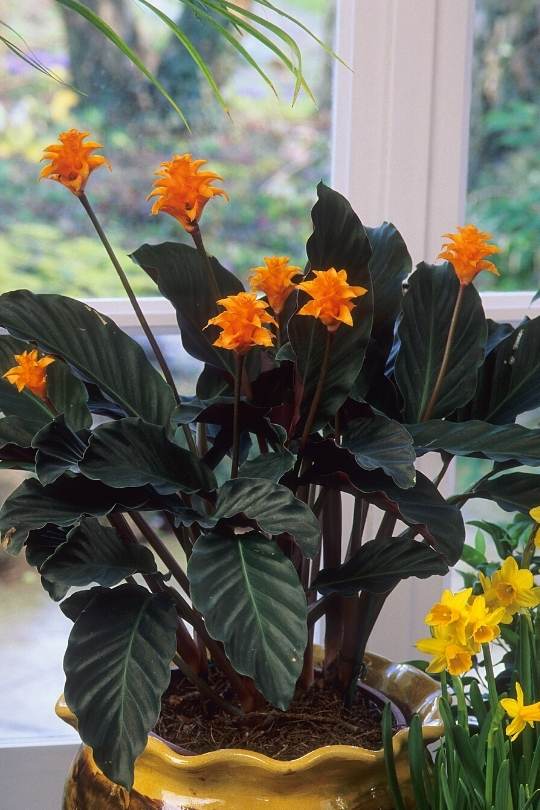
Recently introduced to the houseplant market, eternal flame, Calathea crocata is one of the best bloomers of this genus. The name of this prayer plant refers to the crocus flower, and there is a reason for this. They are bright orange or yellow and with long triangular bracts that give it an oriental look.
The actual sepals are red, and hidden within the bracts. Very much like those of turmeric, in fact, these would look great in an Asian garden. The blossoms will open on straight stems that reach up from the foliage and offer them to you above it.
What’s more, they will last for two to three months! The leaves are deep green, elliptical and pointed, with clear, soft sideways grooves and a very rubbery, almost waxy texture.
Eternal flame is becoming very popular in garden centers, its leaves are quite unusual, and the blooms are just spectacular, and this is making its fortune.
8. Rattlesnake Plant (Calathea Lancifolia)
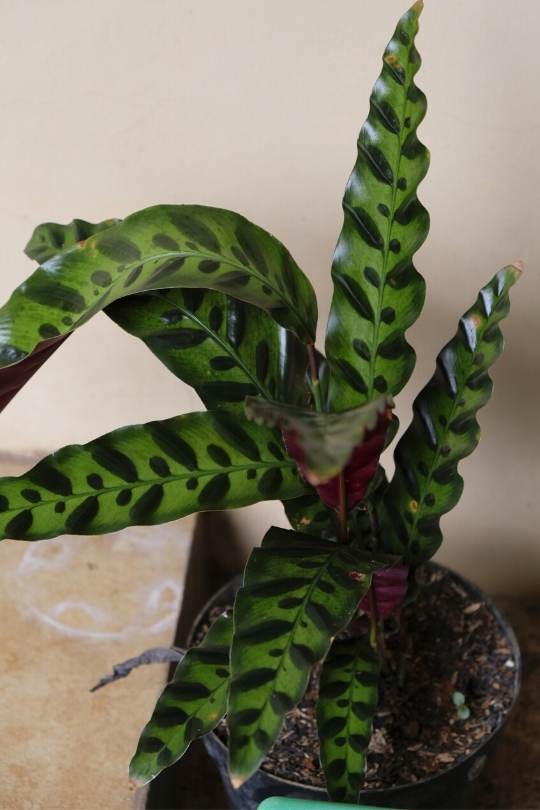
“Lance shaped” prayer plant is the meaning of Calathea lancifolia, known as rattlesnake plant, and it’s a very suitable name for this houseplant variety. Reaching 18 inches in length (45 cm), the leaves are some of the longest in this genus. They are narrow, and very pointed, which makes them look like the tips of spears.
These tend to grow upright, and they have the most amazing coloring. With a dark green stripe along the edges, they are bright green, even lime inside, but with oblong leopard spots of the same dark shade you find on the edges!
Wavy as well, these beautiful “spears” are very glossy indeed. The booms are snow white, with distinct individual heads that look a bit like butterflies at the base of the plant.
Calathea lancifolia is a show stopper for its foliage; the leaves have an African art look on them, very bold and daring in any room that needs some vibrant energy.
9. Calathea Rufibarba (Calathae Rufibarba)
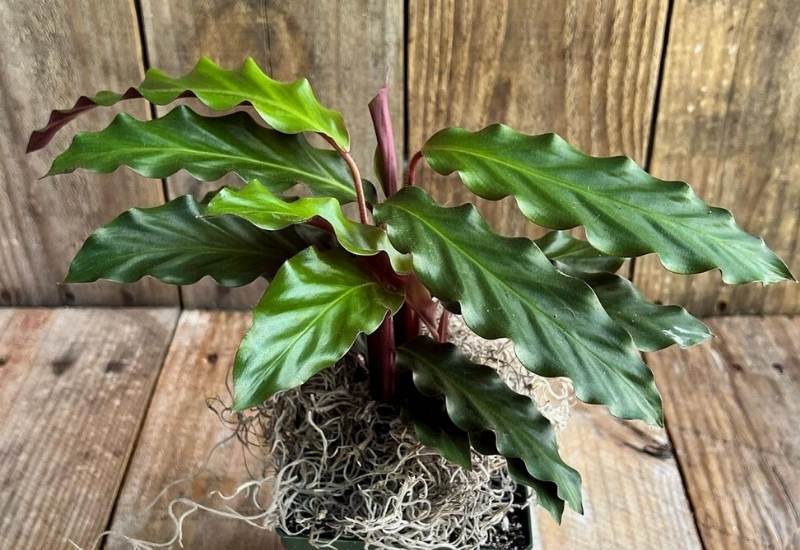
The decorative value of the Brazilian Calathea rufibarba as a houseplant comes from its very refined foliage, in both shape and color.
Very long and thin, the leaves have elegant and regular waves that run from the mid to the edges. This gives it the quality of a finely worked sculpture, which reminds me of ancient bronze age.
And copper to burgundy is the rare color you will see on the undersides, while the top of is glossy and dark green, all mounted on upright and long purple stems. The warm yellow flowers will appear at the base of the leafy clump, with bright, showy and spaced individual heads.
Pick Calathea rufibarba is you want a queen of elegance for a sophisticated room or office space, and it won’t disappoint you!
10. Calathea ‘Freddie’ (Calathea Concinna ‘Freddie’)
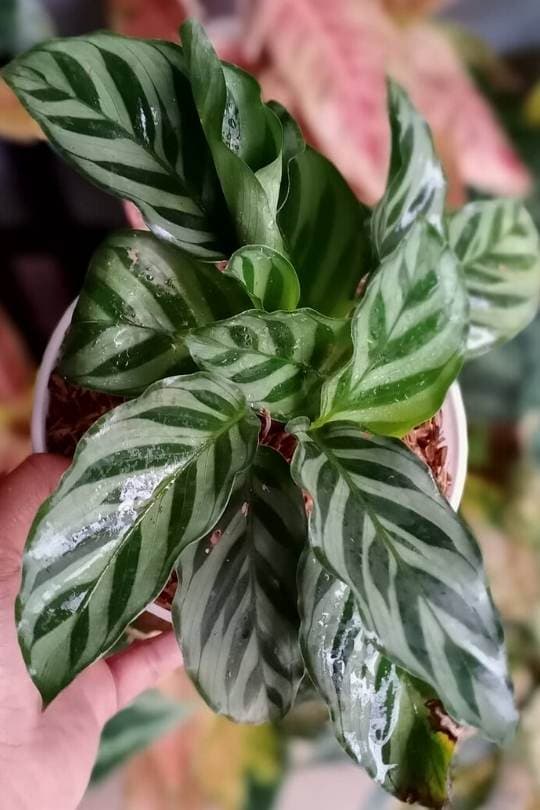
‘Freddie’ is a cultivar of Calathea concinna, a prayer plant native of Brazil, with glossy foliage that looks like big feathers. The dark and lighter bold stripes that run from the mid to the margin give it a very harmonic and regular pattern, just like you find on many birds.
The leaves are quite small compared with other species, 4 to 7 inches in length (10 to 18 inches), but they form very thick and lush clumps that bring you a slice of tropical forest to your indoor spaces.
The snow white inflorescences unfurl from short stems at the base of the plant, slowly revealing the individual sweetly scented flowers.
‘Freddy’ is a playful variety of Calathea concinna; it has a vibrant but also discreet personality, perfect for children and their indoor spaces.
11. Calathea Musaica ‘Network’ (Calathea Musaica PP0005)
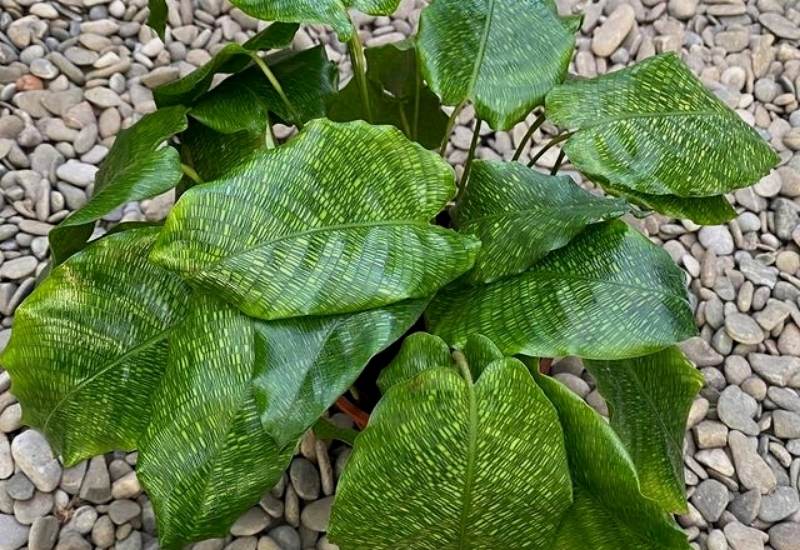
If you like delicate effects, then Calathea musaica is your houseplant. This variety does not have the bold patterns you find on other calatheas, in fact. The very glossy foliage displays a thin, geometrical pattern of tiny rectangular patches of two colors, cream yellow green and bright light emerald green.
It is a plant you want to look at close by to appreciate its full beauty, but even from a distance it has a somewhat puzzling effect with its light effects. The leaves grow on thin stems and they are broad and pointed, forming dense and florid tropical looking clumps.
The blooms are not showy, but beautiful and they will give you candid snow white inflorescences of a few heads each at the base of the plant.
Calathea musaica is perfect as a background houseplant to add texture and green foliage to larger compositions.
12. Calathea ‘Argentea’ (Calathea Picturata ‘Argentea’)
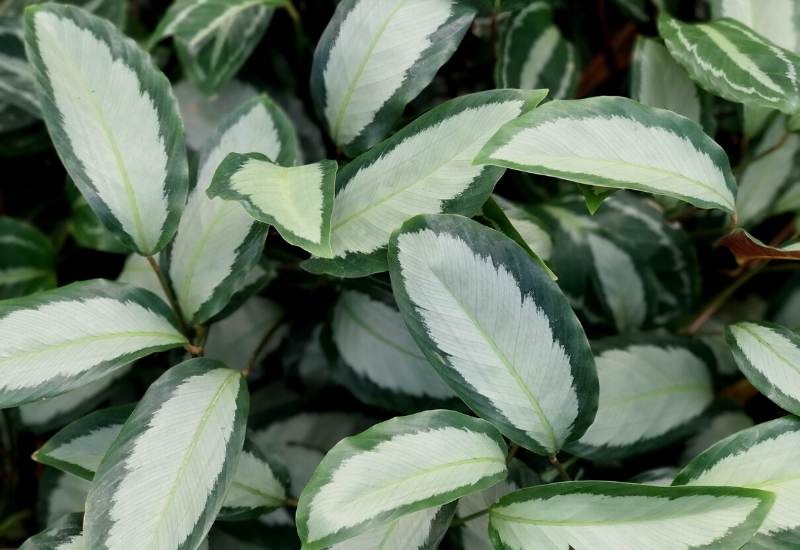
‘Argentea’ is a prayer plant cultivar of the Brazilian Calathea picturata with unique foliage. The leaves have a mid to dark green rim which surrounds a show stopping silver white/ silver green central part, which makes up most of the color ensemble.
They are ovate, about 9 inches long (23 cm) and 6 in width (15 cm), growing horizontally on thin, upright and purple petioles, a shade which is picked up on the undersides as well.
Oddly enough, the star shaped blooms occur individually on stems that bring them to the same height of the foliage itself, roughly speaking. The flowers are white with some yellow, green and pink blushes in them, they look up and very elegant indeed.
‘Argentea’ will attract attention thanks to its very individual silver coloring, beautifully framed; think about the wall shades of your room to make the best of it.
13. Calathea ‘White Fusion’ (Calathea Lietzei ‘White Fusion’)
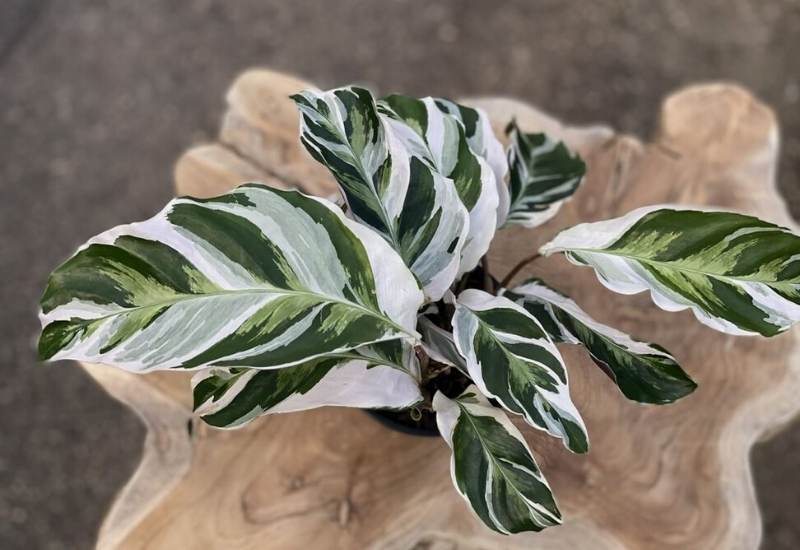
‘White Fusion’ is a prayer plant with unusually irregular patches of color, and a cultivar of the Brazilian Calathea lietzei. Unlike other varieties, the variegation is not predictable. Each leaf will have its own mix, with stripes and dashes of a palette that goes from dark green to white, often prominent, and even some purple blushes on top as well as undersides.
More similar to a modern painting than a traditional pattern, the leaves are elliptical and wavy, with pointed tips and broad shapes.
They will grow as upright cones and then unfurl and bend sideways, revealing all their magnificent tapestry. This late bloomer will also grace your rooms with showy white, purple or yellow flowers.
‘White Fusion’ is ideal for modern looking homes or offices; the rare pure white coloring is a real asset, but it will depend on lighting, so be ready to move it to a brighter place if you don’t get enough of it.
14. Calathea ‘Beauty Star’ (Calathea Ornata ‘Beauty Star’)
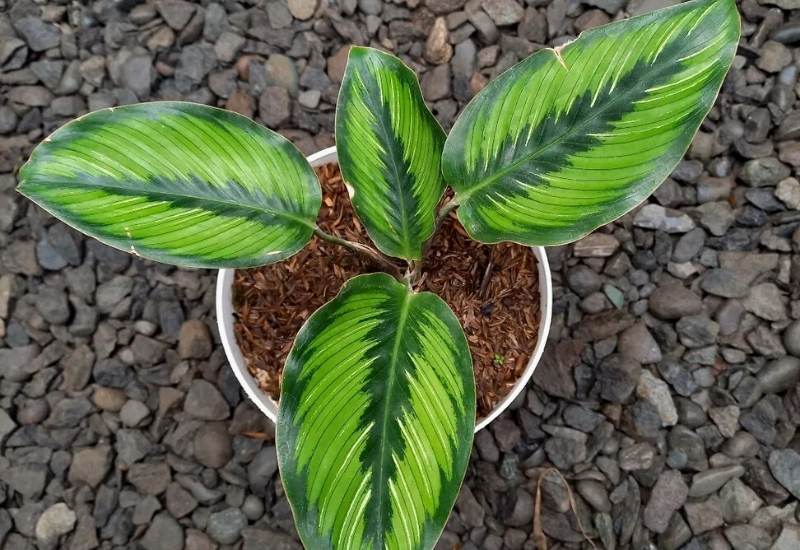
The prayer plant cultivar ‘Beauty Star’ picks up some traits of the mother species Calathea ornata and heightens its elegance. Very glossy, elliptical and pointed, the leaves can reach 1 foot in length (30 cm) and tend to form a rosette shaped clump. These are clearly grooved with arching lines that lead from the mid rib to the edge, but stop just before actually touching them.
This means that the margins are very smooth. On them, you will see gentle diagonal dashes of two shades of green, dark and bright. However, it is not a great bloomer; small and inconspicuous blossoms may appear at the base your houseplant in summer, usually orange.
‘Beauty Star’ is a classical looking variety of prayer plant, and it suits best more formal, traditional rooms, both at home or at work.
15. Medallion Prayer Plant (Calathea Veitchiana)
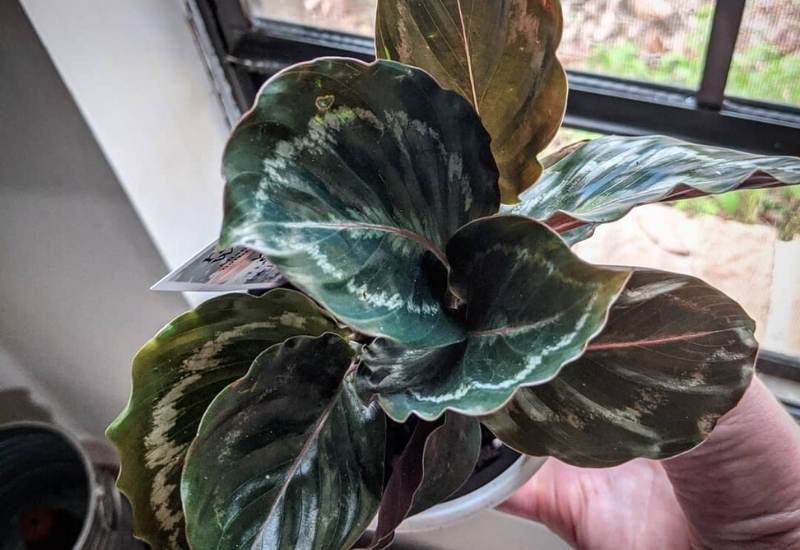
Medallion prayer plant, or Calathea veitchiana, is a the houseplant you want as a work of art in your living room. Its broad, slightly pointed and glossy foliage has made it popular all over the world. Each leaf can be one foot long and almost of the same width (30 cm), but what will amaze you is the pattern you will see on them.
Hard to describe, the series of concentric and feather like stripes of greens that range from almost black to nearly white is a show stopper, especially if you keep them clean and shiny.
The undersides are reddish to purple, as are the petioles. The flowers are small, of a delicate lavender color and they appear among much bigger, bright green bracts.
Medallion prayer plant is one of the most decorative houseplants you can have; it could replace a modern painting with its incredible leaves – this is the plant you want to wow your friends and guests!
16. Calathea Albertii (Calathea Albertii)
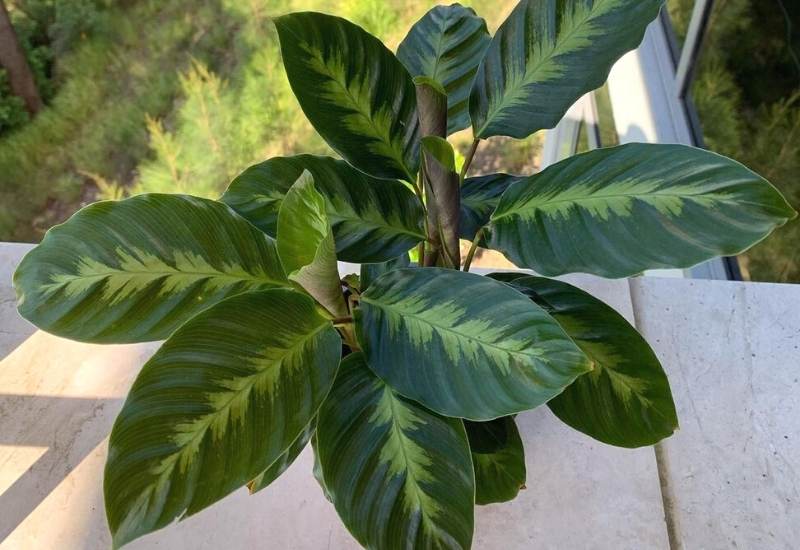
Also known as emerald feather prayer plant, has its own original look, quite distinctive from other varieties, and it may be the one that does for you. The leaves are glossy, long, up to 6 inches long (15 cm) and half as wide, wavy and pointed, but they also tend to curve to one side.
They present stripe, patches and dashes of many shades of green usually two to three, but the exact tonality depends on the light it receives; brighter settings will give you lighter colors, darker ones the opposite.
The undersides, however, will always be purple, sometimes even tending to violet! The blooms are quote small, hidden at the base of the dense foliage, and white green in color.
Emerald feather prayer plant, or Calathea albertii will offer your home the tropical feel, but with a wilder, less tame personality, so, it is better suited to informal spaces. It is also one of the smallest varieties grown as houseplant